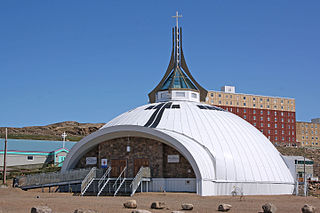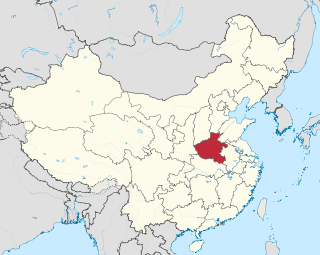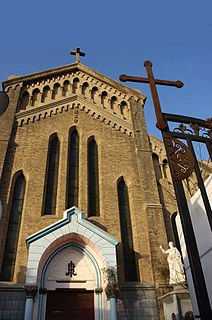
Religion in Canada encompasses a wide range of groups and beliefs.

Christianity in China appeared in the 7th century, during the Tang dynasty, but did not take root until it was reintroduced in the 16th century by Jesuit missionaries. Today, it comprises Catholics, Protestants, Evangelicals and a small number of Orthodox Christians. Although its history in China is not as ancient as Taoism, Mahayana Buddhism or Confucianism, Christianity, through various ways, has been present in China since at least the 7th century and has gained significant influence during the last 200 years. The number of Chinese Christians has increased significantly since the easing of restrictions on religious activity during economic reforms in the late 1970s; Christians were four million before 1949.

Christianity is a minority religion in Sri Lanka. Christianity was introduced to the island in first century, probably in AD 72. Traditionally, after Thomas the Apostle's visit in Kerala in AD 52, Christianity is said to have been introduced via India because of its close geographical and commercial ties. According to Christian traditions, the apostle Thomas preached the Gospel in Sri Lanka Records suggest that St. Thomas Christians and Nestorian Christians lived in Sri Lanka. Anuradhapura cross is one of the archaeological claims that suggest Christianity in Sri Lanka before Portuguese. Roman Catholicism was introduced by the Portuguese in 1505. There were conversions by Dutch persons in the 17th century, which resulted in a percentage of church members in excess of 10%.

Christianity is the most adhered to religion in the United States, with 75% of polled American adults identifying themselves as Christian in 2015. This is down from 85% in 1990, lower than 81.6% in 2001, and slightly lower than 78% in 2012. About 62% of those polled claim to be members of a church congregation. The United States has the largest Christian population in the world, with nearly 240 million Christians, although other countries have higher percentages of Christians among their populations.

Christianity is the dominant religion in Zimbabwe.
Religion in Jamaica, according to the most recent census (2001), consists of a breakdown of 66% Christian, 3% unstated, and 10% other. The category other includes 29,026 Rastas, an estimated 5,000 Muslims, 3,000 Buddhists 1,453 Hindus, and approximately 200 Jews. The census reported 21% who claimed no religious affiliation. The largest religion indigenous to Jamaica is Rastafari.

St. Michael's Cathedral, also called the Zhejiang Road Catholic Church, is a Catholic church in Qingdao (Tsingtao), Shandong Province, China and is the seat of the Bishop of the Roman Catholic Diocese of Qingdao. It is located in the oldest part of Qingdao, at 15 Zhejiang Road, on the east side of Zhongshan Road in Shinan District. Built by German missionaries, the cathedral stands at the top of a hill in the center of the old German-built part of the city. It is the largest example of Romanesque Revival architecture in the province, resembling a German cathedral of the 12th century.
Christianity is a minority religion within Karnataka, a state of India. Mangalorean Catholics are a community of centuries, though there also are Mangalorean Protestants. A Roman Catholic Diocese of Mangalore, a Roman Catholic Diocese of Belgaum, a Roman Catholic Archdiocese of Bangalore, a Roman Catholic Diocese of Bellary, a Roman Catholic Diocese of Gulbarga, a Roman Catholic Diocese of Shimoga, a Roman Catholic Diocese of Mysore, a Roman Catholic Diocese of Karwar, a Roman Catholic Diocese of Udupi are present in Karnataka. The second largest church in Karnataka is the Church of South India with Karnataka Central Diocese, Karnataka Northern Diocese and the Karnataka Southern Diocese. Gangavathy has Mennonite Brethren Churches. An Anglican Body-India Christian Mission Church has its existence in Doddaballapur of Bangalore rural right from 1920s. There is also an Orthodox Diocese of Bangalore. The state had a relatively high number of anti-Christian attacks in 2009. More than 20 churches were devastated by the Hindu nationalist movement Bajrang Dal in 2008. In 2008, Karnataka had more than 100 anti-Christian attacks.
Anhui province of China has one of the largest Christian populations of regions of East Asia. It includes millions of people. Christianity in Henan is one of the largest Christian populations in East Asia as well. The Shouters are active in the province. The defunct Apostolic Vicariate of Kiang-nan had a long history. The country has Persecution of Christians. Watchman Nee died a martyr in an Anhui labour-camp in 1972.
Christianity is a minority in Fujian province of China. The Shouters are present in the province. Churches in Fujian include The Aowei Church of Holy Rosary, Church of Heavenly Peace, Fuzhou, Flower Lane Church, Saint Dominic's Cathedral, Fuzhou and St. John's Church, Fuzhou. Christianity in Fuqing consisted of 350,000 Christians in the 2000s and is a centre of Christianity. The Local churches (affiliation) are estimated to include about half of them. The number of members of the Three-Self Patriotic Movement in Fujian is a high 6-digit figure at least. There are at least 80,000 members of the True Jesus Church in the province. Fujian has many house churches. Christianity has been present in Fujian for centuries. The People's Republic of China has persecution of Christians. Unregistered Catholics are controlled tightly in the province. A house church in Pingtan in Fujian province was demolished in 2006.
Christianity is a minority in Hebei province of China. The Shouters are present in the province. China has persecution of Christians. A significant minority of the Catholics of China is in Hebei. Bishop Yao Liang was from Hebei. Guo Jincai has been made a bishop of Chengde in Hebei without consent of the pope. Roman Catholic bishop Jia Zhiguo was arrested in 2008. Catholic bishops Su Zhimin and Shi Enxiang from Hebei have been sent to prison by 2010. Beifang Jinde is a charitable Catholic institution in Shijiazhuang.
Christianity is a minority in Yunnan province of China. The Shouters are present in the province. There are more than a million Protestants in the province. Yunnan has persecution of Christians. Fugong has a Christian majority. Nujiang has a notable Christian minority. Many of the A-Hmao and Eastern Lipo are Christians. Yunnan has Hmong Churches and many Lisu Churches. Han Chinese are a minority among the Christians in the province.
Christianity is a minority in Jilin, a province of China. St. Theresa's Cathedral and Changchun Christian Church exist in Changchun. Kim-Jong-il visited a Catholic church in the province in 2010. There were raids against many house churches of Jilin in 2005. At least 600 were arrested. The province has hundreds of thousands of Protestants. The number of Protestants decidedly exceeds that of the Catholics. It has occurred, that churches in Yanbian Korean Autonomous Prefecture have been shut down. Jilin City has a Catholic church built after Gothic models.
Christianity is a minority in Sichuan province of the People's Republic of China. Eastern Lipo, Kadu people and A-Hmao are ethnic groups present in the province. Mgr Artus de Lionne became apostolic prefect of Sichuan in 1696. Chengdu has a seminary. On June, 20th, 2009, the police in Langzhong set free 18 house church leaders arrested on June, 9th. A Sichuan Theological College exists. the Catholic population of the province is estimated at 250,000 persons. In 1950 it was estimated there were more than 50,000 Protestants in Sichuan, meeting in hundreds of churches and chapels.
Christians are a minority in Inner Mongolia region of the People's Republic of China. There are Orthodox Churches in Labdarin, Manzhou and Hailar. The Shouters are active in Inner Mongolia. About 100,000 Chinese Christians were in the region in 1993. The region has few Mongolian Christians. Numerous house church leaders were detained in Xilinhot in 2008. Inner Mongolia is an area of rapid growth of Protestantism. Religious Affairs Bureau staff have declared a Christmas gathering in Duolun County illegal in 2006. Inner Mongolia Bible School was founded in 1987. Inner Mongolia has more than 170,000 Protestants and over 1,000 official churches. Tongsun Street Church was started with the help of Swedish missionaries around 1900. According to Tjalling Halbertsma, Christians used to live in Inner Mongolia before 1206. Hohhot used to have or has a very large house church with more than 1500 church members. Protestantism entered the region in the late 19th century. Due to the Dungan Revolt (1895–96) the western Inner Mongolian Han Chinese Catholic village Xiaoqiaopan had defensive procedures institted by the Belgian Priests in charge. Missionaries were killed during the Boxer Rebellion in 1900. The French Catholic vicar apostolic, Msgr. Alfons Bermyn wanted foreign troops garrisoned in inner Mongolia, but the Governor refused. Bermyn petitioned the Manchu Enming to send troops to Hetao where Prince Duan's Mongol troops and General Dong Fuxiang's Muslim troops allegedly threatened Catholics. It turned out that Bermyn had created the incident as a hoax. In Fengzhen, a church was founded as early as 1892. Most Christians in Inner Mongolia are Han Chinese.

Kaifeng railway station is a station on Longhai railway in Kaifeng, Henan.










